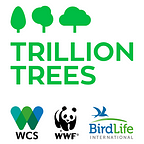Reforestation… the right way
“Pledges are all very well, but let’s pledge for the planet, not just for carbon. It’s time to focus on the kind of forest restoration that really delivers,” says Trillion Trees Executive Director, John Lotspeich
Everyone, it seems, is planting trees. Pledges are flying in thick and fast: the 1t.org campaign alone has accumulated promises amounting to 2.5 billion trees from companies worldwide, and another 157 million were added to the tally at last month’s Global Citizen Live event, as governments, philanthropists and corporates made commitments. More will doubtless follow when COP26 swings into action in Glasgow next month.
The Trillion Trees partners came together five years ago around the belief that forests can provide an immediate, actionable solution to meet the triple threat that imperils our world — fighting climate change, stemming biodiversity loss and addressing economic insecurity for the 86 million people whose livelihoods depend on them. We’re excited about the ever-increasing awareness of the power of trees — the more on the bandwagon, you might say, the merrier. However, there is a caveat, and it’s an important one: for lasting impact, forest restoration must be done properly — in the right places, with the right trees, and using the right methods.
Successful forest restoration is much more than a number, and too often we discern a lack of rigour underpinning these well-intentioned commitments. Where will the trees be planted, and exactly who will be planting them? Have the long-term goals been articulated; have local people been engaged to take part and support the project? And what of the outcomes: will there be scrupulous monitoring — a proper interrogation of the real-world benefits of these schemes over the years and decades ahead? How many trees actually survive years later? The answers are not always clear, and investors looking to rally behind our movement need clarity when deciding who to support and how best to commit their funds. It’s the only way to guarantee their money will make a genuine difference on the ground.
Since I joined Trillion Trees just over a year ago, we’ve worked hard to promote this evidence-driven approach: there is a full delivery plan attached to every project we engage in, along with results-based objectives that measure change. We’ve written to Rt Hon Alok Sharma MP, the president of COP26, to urge him to take the lead on this era-defining challenge. Delegates to COP26 must ensure that all their reforestation efforts contribute to the restoration of ecosystems and harness the vast range of co-benefits they bring for people, nature and the climate. Reforestation has many forms, we know, but the top priority must be to protect what standing forests we have and to restore sensitively so we can get our natural forests back, protecting and ultimately expanding these important landscapes. If we restore well, we can capture carbon in a way that’s appropriate for the landscape, and by extension, hold ourselves accountable for supporting the rights of the communities who make their living there.
To the delegates of COP we offered our three guiding principles for forest restoration:
Restore in the right way: which means to natural forest wherever possible. Repairing and extending native forests is often quicker and more efficient than intensive afforestation, and it boosts ecological resilience. It captures more carbon and benefits communities — improving their water supply, for example, or offering new income from ecotourism.
Restore in the right place: using existing data to select landscapes where forest has the best chance to thrive. That tends to mean restoring at the forest frontier, and reconnecting fragments of habitat to allow wildlife to spread. This approach also protects other ecosystems such as peatlands or grasslands, which are critical for biodiversity and play a huge role in capturing carbon.
Restore the right trees: the default should be to let nature take the lead through natural colonisation, which automatically ensures the right trees are in the right place. Where the land is degraded and we must plant, mixed forests of native trees not only support biodiversity; they are more resistant to disease, fire and extreme weather than monocultural plantations can ever be.
Trillion Trees partners want to see effective forest restoration defined in international frameworks, using criteria that optimise climate stability, biodiversity and sustainable prosperity for people. And an acknowledgement, over everything, that plantations of non-native species, while often needed and economically sound, are not the same as natural forests, and so do not provide the same benefits.
With billions of dollars waiting to be unleashed in our cause, it would be disastrous if they were channelled incoherently, and failed to achieve the rapid progress we need. So, when COP26 draws to a close, and as we look to the pledges made in the next fortnight, Trillion Trees will publish a step-by-step guide to help investors understand what forest conservation with impact can look like. Shaped by our partners’ 100+ years of combined experience in the field, and by Kew’s 10 Golden Rules for restoring forests, the toolkit will give funders a practical guide to making choices when investing for impact, encourage them to enquire more deeply of the value proposition of restoration projects. We hope this will ensure that biodiversity and social gain are embedded in the programs they support.
We are encouraged by the explosion of recent tree-planting pledges and acknowledge that it’s now time to turn them into action. We intend to show the way. Because without informed decision-making, we could end up where we don’t want to be — in a greenwashed world. To donate to the Trillion Trees Reforest Fund click here.
